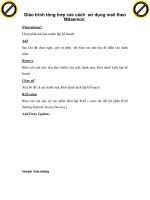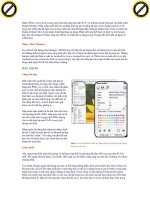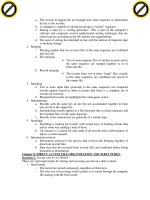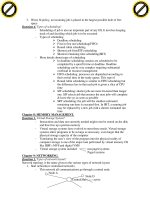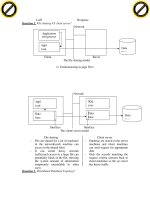Giáo trình tổng hợp các cách sử dụng máy in laser một cách hiệu quả và tiết kiệm phần 3 pps
Bạn đang xem bản rút gọn của tài liệu. Xem và tải ngay bản đầy đủ của tài liệu tại đây (510.5 KB, 5 trang )
việc với bất kỳ tập tin flv nào mà bạn tải về từ bất kỳ dịch vụ chia sẻ video nào chứ không chỉ YouTube.
Hồng Anh
PC World Mỹ 12/2006
Làm vệ sinh cho các thanh RAM và Card
(Dân trí) - Các thanh RAM và card chức năng (card màn hình, card sound,
modem…) lâu ngày sử dụng sẽ bám bụi, nhất là những khe cắm AGP hay
PCI trên mainboard. Bài viết sẽ hướng dẫn cách làm vệ sinh cho chúng.
Có thể dùng cọ quét sơn loại nhỏ hay ống xịt bụi làm sạch bụi bẩn, nhưng riêng
đầu cắm (có những chân cắm màu vàng) thì có thể xảy ra hiện tư
ợng hoen ố do bụi bám
lâu ngày gây nên.
Để làm được việc này thật đơn giản và hiệu quả giúp cho những card của chúng ta luôn
mạnh khỏe và bền bạn chỉ cần làm các bước sau:
- Một cục tẩy bút chì (không dùng tẩy bút mực), khăn giấy.
- Tắt nguồn, chờ 15 phút và tháo các card chức năng.
- Lấy cục tẩy chà đi chà lại 4-5 lần theo chiều dọc vào các chân cắm màu vàng,
dùng khăn giấy phủi nhẹ, rồi tiếp tục chà, đến khi nào bạn cảm thấy sáng sủa, hết bụi,
vết hoen ố mờ hẳn thì thôi.
- Dùng ống xịt bụi hay cọ quét sơn quét lại bụi, làm sạch bụi ở các khe cắm card
trên mainboard. Xong việc bạn có thể cắm lại vào máy và vận hành tiếp.
Hoa Đào
Computer system
Click to buy NOW!
P
D
F
-
X
C
h
a
n
g
e
V
i
e
w
e
r
w
w
w
.
d
o
c
u
-
t
r
a
c
k
.
c
o
m
Click to buy NOW!
P
D
F
-
X
C
h
a
n
g
e
V
i
e
w
e
r
w
w
w
.
d
o
c
u
-
t
r
a
c
k
.
c
o
m
Computer System
Book I: computer system fundamentals.
Chapter 1: INTRODUCTION TO COMPUTER.
Question 1. What is a computer?
A computer may be defined as a machine which accepts data from an input device,
processes it by performing arithmetical and logic operations in accordance with a
program of instructions and returns the results through an output unit.
A computer is basically an electronic machine operating on current.
Question 2. Components of a Computer system?
A computer system comprises of the following components:
1. Central Processing Unit (CPU).
- CPU is the heart of the whole sys
- CPU consists of the :
control unit (CU)
arithmetic logic unit (ALU)
accumulator (ACC)
Click to buy NOW!
P
D
F
-
X
C
h
a
n
g
e
V
i
e
w
e
r
w
w
w
.
d
o
c
u
-
t
r
a
c
k
.
c
o
m
Click to buy NOW!
P
D
F
-
X
C
h
a
n
g
e
V
i
e
w
e
r
w
w
w
.
d
o
c
u
-
t
r
a
c
k
.
c
o
m
program counter (PC)
instruction register (IR)
memory address register (MAR)
memory data register (MDR)
status register (SR)
general purpose register
- The function of each components of CPU:
Control unit:
control and co_ordinate all hardware functions of the CS.
examine and decode all program instructions to the
computer and initiate their execution by sending the
appropriate signals.
ALU:
performs all arithmetic <addition, subtraction,
multiplication, division & exponentiation> and logic
comparision two values functions required by computer.
ACC:
holds the first operand of the temporary result of the ALU.
PC:
contains the add of the next instruction to be excuted.
IR:
contains the current instruction to be executed.
Main memory
MAR:
holds the address location to or from which data is to be
transferred
MDR:
contains the data to be written to or read out of the
addressed location.
SR:
keeps track of the status of the accumalator.
General Purpose Register:
for general purpose procedures.
Please refer to diagram for an illustratin of the basic components of the CPU.
Click to buy NOW!
P
D
F
-
X
C
h
a
n
g
e
V
i
e
w
e
r
w
w
w
.
d
o
c
u
-
t
r
a
c
k
.
c
o
m
Click to buy NOW!
P
D
F
-
X
C
h
a
n
g
e
V
i
e
w
e
r
w
w
w
.
d
o
c
u
-
t
r
a
c
k
.
c
o
m
I
N
T
E
R
N
A
L
CPU
Control unit
Arithmetic Logic Unit
Accumulator
Program Couter to main
Instruction Register memory
Memory Address Register
Memory Data Register
Status Register
General Purpose Register
Basic components of a CPU.
Control Unit
Input Unit ALU Output Unit
Main Memory
Backing Storage
Control signals
Data flow
Components of a CS.
2. Input units
- Used to enter data( raw unprocessed facts) and instructions to the
computer.
3. Output units
- Used for delevering the processed result from the computer in useful form.
4. Backing storage units
- Backing storage units need for high capacity data storage devices that can
store data in a more permanent form for later retrieral, updating and
referencing.
- Backing storage is also called secondary storage external storage and
auxiliary storage.
B
U
S
Click to buy NOW!
P
D
F
-
X
C
h
a
n
g
e
V
i
e
w
e
r
w
w
w
.
d
o
c
u
-
t
r
a
c
k
.
c
o
m
Click to buy NOW!
P
D
F
-
X
C
h
a
n
g
e
V
i
e
w
e
r
w
w
w
.
d
o
c
u
-
t
r
a
c
k
.
c
o
m
Chapter 2: MICOPROCESSOR.
Question 1. Cache Memory?
- Cache memory is a small amount of very fast store with faster access time
than the main memory.
- Cache memory is used to temporaryty store data instructions that are likely
to be retrieved many times, thus speeds up the processing of data.
- Sits between main storage and the processor acting as holding area through
which all data and instructions pass.
- Old data in the cache memory is over written by new then cache is full.
Question 2. Virtual Memory?
- Virtual memory makes use of both the main memory and backing store.
- In a virtual memory sys, each user has the illusion that his program is in
the main memory all the time.
- The sys maintains this illusion by keeping some of the “unused” portion of
the program’s code and data on a backing store device which is usually
magnetic disk
- The movement of the unused portion from the backing store to the mian
memory is transparent to the users.
- Please refer to diagram for virtual memory.
Backing Store Main Memory
Virtual Memory
Chapter 3: BATCH/ ONLINE AND REAL TIME PROCESSING SYSTEM.
Question 1. Batch Processing System?
- Def: Computer processing does not begin until all the input data has been
collected and grouped together called Batched Generally data is
accumulated for a certain period of time or unitl a certain quantity.
- Ads:
Response time is not critical.
Need to process large volumn of data.
Computer efficiency is more important than response time.
- Dis:
Time between recording and processing of source
document is long
A3
A1
A2
A2
A3
A1
Click to buy NOW!
P
D
F
-
X
C
h
a
n
g
e
V
i
e
w
e
r
w
w
w
.
d
o
c
u
-
t
r
a
c
k
.
c
o
m
Click to buy NOW!
P
D
F
-
X
C
h
a
n
g
e
V
i
e
w
e
r
w
w
w
.
d
o
c
u
-
t
r
a
c
k
.
c
o
m
